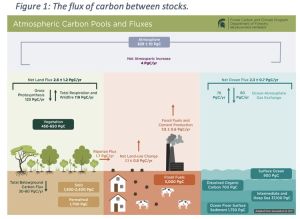Carbon Stocks
"A carbon stock, or carbon pool, is a system that has the capacity to store or release carbon. A carbon flux refers to the amount of carbon exchanged between carbon stocks over a specified time. In simple terms, it is the movement of carbon between land, oceans, atmosphere, and living things."[1]
Related
Aquatic Carbon Fluxes | Carbon cycle | Leaf Litter Decomposition | Forest carbon storage | Soil Carbon
Vegetation
As shown in the figure, vegetation absorbs 123 PgC yr-1 and they do this through photosynthesis, where carbon is sequestered and metabolized and stored as sugars. Vegetation also releases 119 PgC yr-1 back into the atmosphere from respiration, decomposition, and other disturbance events like wildfires. As a result, the net (or total) land carbon flux results in an loss atmospheric carbon and increase in vegetative carbon at approximately 2.6 ± 1.2 PgC yr-1. Moreover, forest carbon loss can occur in response to climate-induced disturbances– including fire, pests, and invasive species– which could outweigh the greenhouse gas (GHG) mitigation benefits of existing carbon stocks.[2]
